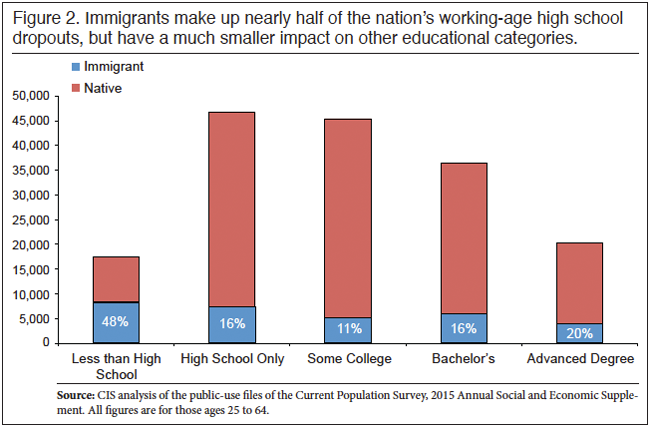The Pew Hispanic Center recently noted an uptick in the education level of recent immigrants vis a vis natives. For example, while 11 percent of recent arrivals in 1990 had a post-graduate degree, 18 percent of new immigrants had one in 2013. The percentage of natives 25 and older with a post-graduate degree also increased during that time period, but only from 7 percent to 11 percent.
While a relative reduction in low-skilled immigration is always welcome news, some perspective is needed here.
The distribution of immigrant education has been "bimodal" for a half century, with some highly educated immigrants joined by many newcomers with much lower skill levels. Table 1 shows there are twice as many immigrants ages 25 to 64 who have not graduated high school as there are with a graduate degree. In contrast, there are almost twice as many natives with a graduate degree as natives who have not completed high school. (We use the age range of 25-64 because elderly Americans are usually retired and therefore less relevant to a labor market analysis.)

Figure 1 and Table 2 show that 27 percent of working-age immigrants are high school dropouts, vs. just 7 percent of working-age natives. And although 32 percent of immigrants have a four-year college degree or more, that figure is actually slightly lower than the 35 percent of natives who have at least a college degree.


The cumulative impact of decades of low-skilled immigration cannot be undone by a few years of somewhat more skilled immigration. Figure 2 compares the proportions of immigrants and natives (25 to 64) in five different educational categories. Remarkably, fully 48 percent of all working-age high school dropouts in the United States are foreign-born. Put another way, the past generation of mass immigration has almost doubled the number of unskilled workers in the American labor market.

Seen from that perspective, it is clear that modest year-to-year changes in immigrant education can do little to change the enormous challenges that the arrival of so many low-skilled immigrants over the last five decades has created for the country. For example, nearly one-third of all the children in poverty today live in an immigrant family. It will likely take decades to address this problem even if there is an increase in the skill level of immigrants who arrive in the future.
It is also difficult to predict what the future holds. Pew's reported uptick in education levels could be the beginning of a new era of higher-skilled immigration, or it could be just a random blip on the path to ever more unskilled labor.
New evidence points to a blip. Pew's data ends in 2013, but CIS has found that the Mexican immigrant population (which is overwhelmingly low-skilled) jumped upward between 2013 and 2015 after declining over a period of five years. Perhaps as a result, 21 percent of 18 to 64 year old immigrants who arrived between 2012 and 2015 were high school dropouts, vs. 19 percent who arrived between 2008 and 2011. Is this a new trend or itself just a blip? It's hard to know.
What we do know is that future immigration will remain unpredictable as long as we continue to have a policy based primarily on family preferences. If we want highly skilled immigrants who will generally earn high incomes, and consume little in public welfare, then we should set admissions criteria explicitly on that basis.
